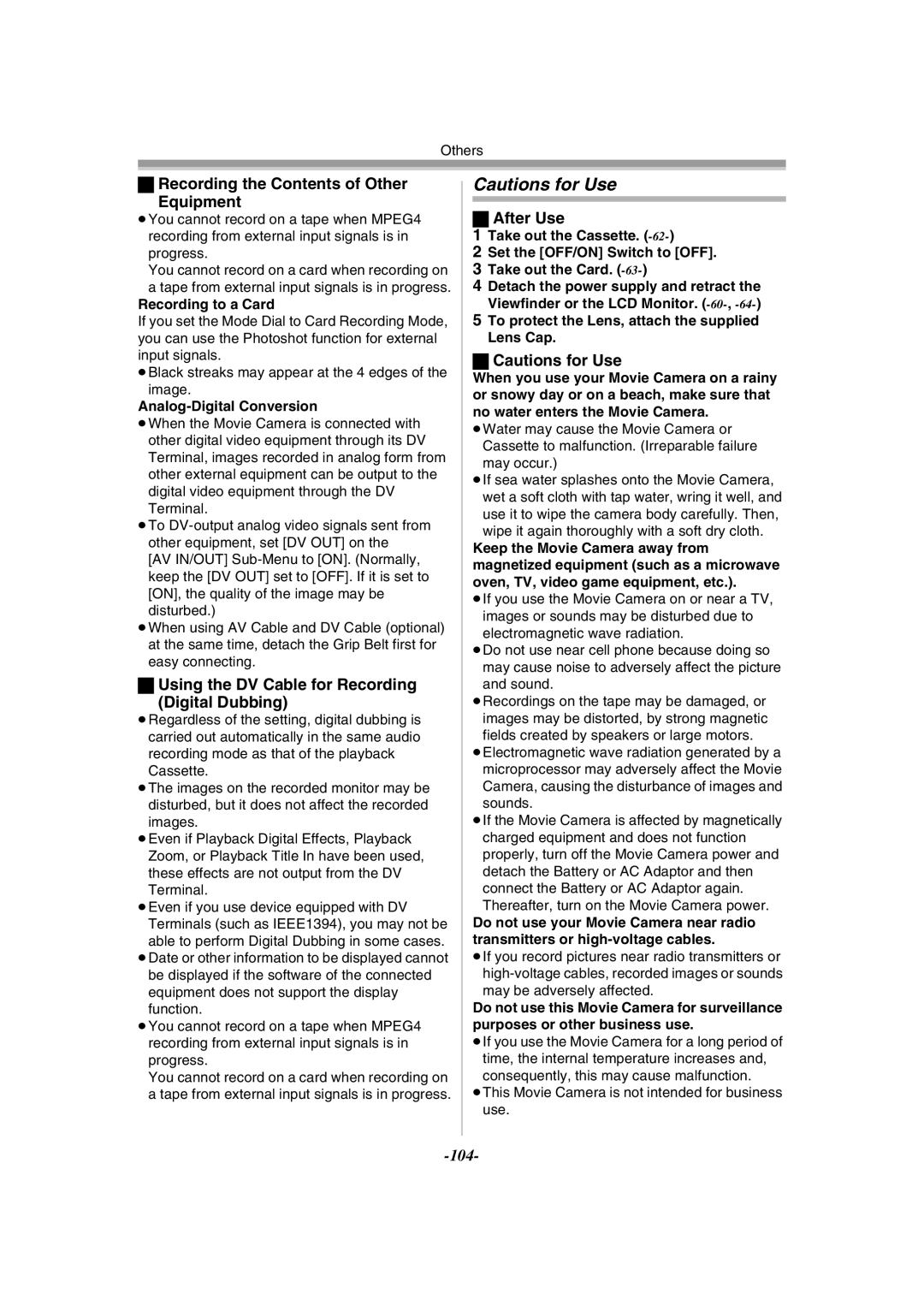
Others
ªRecording the Contents of Other
Equipment
≥You cannot record on a tape when MPEG4 recording from external input signals is in progress.
You cannot record on a card when recording on
a tape from external input signals is in progress.
Recording to a Card
If you set the Mode Dial to Card Recording Mode, you can use the Photoshot function for external input signals.
≥Black streaks may appear at the 4 edges of the
image.
≥When the Movie Camera is connected with other digital video equipment through its DV Terminal, images recorded in analog form from other external equipment can be output to the digital video equipment through the DV Terminal.
≥To
[AV IN/OUT]
[ON], the quality of the image may be disturbed.)
≥When using AV Cable and DV Cable (optional) at the same time, detach the Grip Belt first for easy connecting.
ªUsing the DV Cable for Recording
(Digital Dubbing)
≥Regardless of the setting, digital dubbing is carried out automatically in the same audio recording mode as that of the playback Cassette.
≥The images on the recorded monitor may be disturbed, but it does not affect the recorded images.
≥Even if Playback Digital Effects, Playback Zoom, or Playback Title In have been used, these effects are not output from the DV Terminal.
≥Even if you use device equipped with DV Terminals (such as IEEE1394), you may not be able to perform Digital Dubbing in some cases.
≥Date or other information to be displayed cannot be displayed if the software of the connected equipment does not support the display function.
≥You cannot record on a tape when MPEG4 recording from external input signals is in progress.
You cannot record on a card when recording on a tape from external input signals is in progress.
Cautions for Use
ªAfter Use
1Take out the Cassette.
2Set the [OFF/ON] Switch to [OFF].
3Take out the Card.
4Detach the power supply and retract the Viewfinder or the LCD Monitor.
5To protect the Lens, attach the supplied Lens Cap.
ªCautions for Use
When you use your Movie Camera on a rainy or snowy day or on a beach, make sure that no water enters the Movie Camera.
≥Water may cause the Movie Camera or Cassette to malfunction. (Irreparable failure may occur.)
≥If sea water splashes onto the Movie Camera, wet a soft cloth with tap water, wring it well, and use it to wipe the camera body carefully. Then,
wipe it again thoroughly with a soft dry cloth.
Keep the Movie Camera away from magnetized equipment (such as a microwave oven, TV, video game equipment, etc.).
≥If you use the Movie Camera on or near a TV, images or sounds may be disturbed due to
electromagnetic wave radiation.
≥Do not use near cell phone because doing so may cause noise to adversely affect the picture and sound.
≥Recordings on the tape may be damaged, or images may be distorted, by strong magnetic fields created by speakers or large motors.
≥Electromagnetic wave radiation generated by a microprocessor may adversely affect the Movie Camera, causing the disturbance of images and sounds.
≥If the Movie Camera is affected by magnetically charged equipment and does not function properly, turn off the Movie Camera power and detach the Battery or AC Adaptor and then connect the Battery or AC Adaptor again.
Thereafter, turn on the Movie Camera power.
Do not use your Movie Camera near radio transmitters or
≥If you record pictures near radio transmitters or
Do not use this Movie Camera for surveillance purposes or other business use.
≥If you use the Movie Camera for a long period of time, the internal temperature increases and, consequently, this may cause malfunction.
≥This Movie Camera is not intended for business use.
